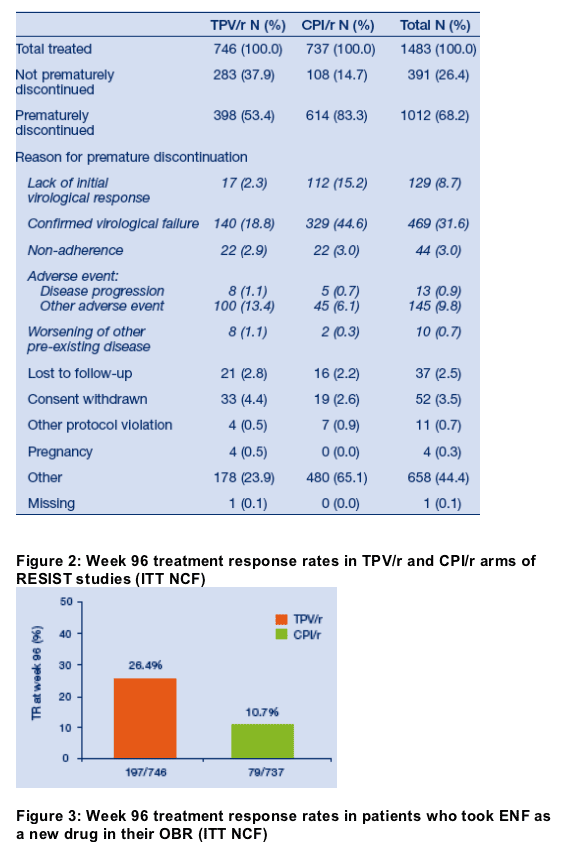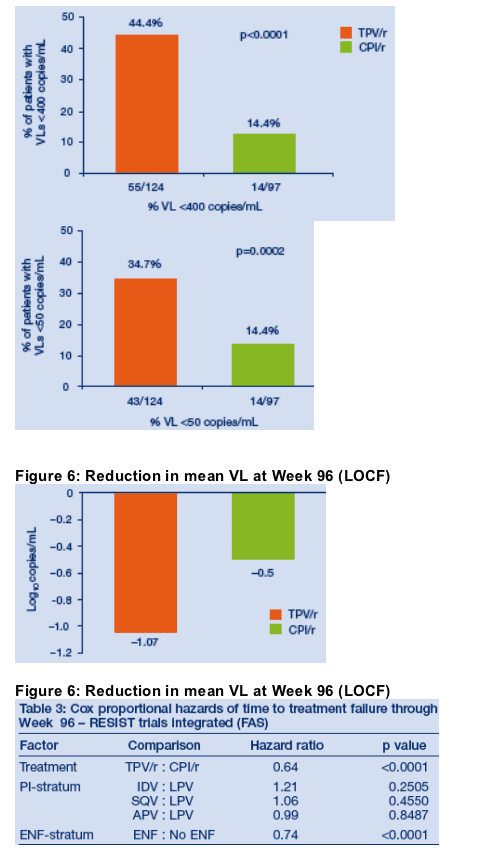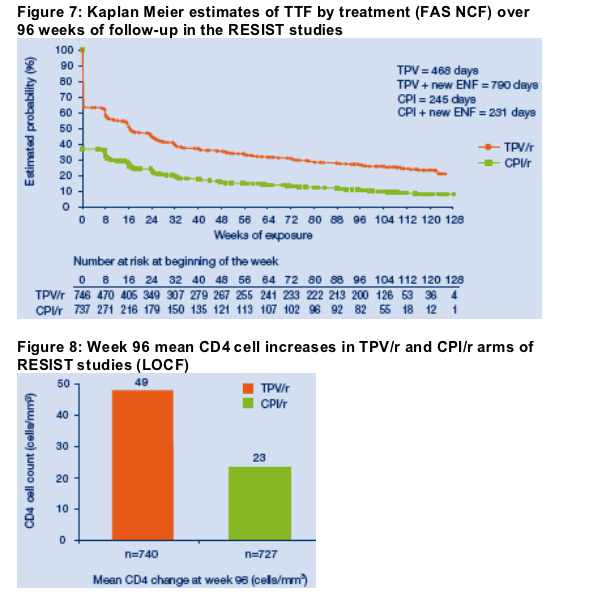 |
 |
 |
| |
Combined analysis of RESIST 96 week data: durability and efficacy of tipranavir/r in treatment-experienced patients
|
| |
| |
Reported by Jules Levin
Eighth International Congress on Drug Therapy
in HIV Infection
Glasgow, UK, 12-16 November 2006
B Gazzard1, A Antinori2, C Cheli3, D Neubacher4
1Chelsea and Westminster Hospital, London, UK; 2Istituto Lazzaro Spallanzani, Roma, Italy;
3 Boehringer Ingelheim Pharmaceuticals, Inc., CT, USA; 4Boehringer Ingelheim Pharma GmbH & Co. KG, Biberach, Germany
Author Conclusions
The Week 96 results of the RESIST studies confirm the durable superiority of TPV/r regimens over those containing CPI/r in highly treatment experienced patients infected with HIV-1 that exhibited reduced susceptibility to at least two PIs.
Combining TPV/r with another active drug, e.g. ENF, resulted in superior virological and immunological responses.
The time to treatment failure was significantly longer for those treated with TPV/r
compared to those treated with CPI/r.
By Week 96, more than twice as many patients had achieved a VL <400 copies/mL or <50 copies/mL in the TPV/r arm as compared to the CPI/r arm.
CD4 cell count increases from baseline (mean values) were approximately two-fold higher in the TPV/r arm than in the CPI/r arm by Week 96.
A substantial proportion of RESIST patients who took TPV/r and another new ARV, such as ENF, were able to achieve virological suppression (VL <50 copies/mL), as recommended in current guidelines.
Abstract
Tipranavir/ritonavir (TPV/r) exhibited potent activity and superiority to comparator ritonavir-boosted protease inhibitors (CPI/r) in highly treatment experienced (HTE) patients at Weeks 24 and 48 of RESIST studies. We present the RESIST Week 96 responses.
Patients were ≥3-class ARV experienced; ≥2 PI regimens; had ≥1 primary PI mutation. Patients were randomized to TPV/r (500/200 mg) or CPI/r plus optimized background regimen. Treatment response (TR) rates, time to treatment failure (TTF), and % patients with viral loads (VL) <400 and <50 copies/mL were determined.
1483 patients randomized and treated: 746 TPV/r; 737 CPI/r. 21% took enfuvirtide (ENF). Median baseline VLs: 4.79/4.8 log10 copies/mL in TPV/r/CPI/r groups; CD4 cell counts: 158/166 cells/mm3. At Week 96, TRs were 26.4% (TPV/r) and 10.7% (CPI/r) (p<0.0001). In the TPV/r group, TR was 23.1% in non-ENF stratum versus 37.6% in ENF stratum at Week 96.
TTF was significantly longer in patients who took TPV/r versus CPI/r (HR: 0.64, p<0.0001) and in those who took ENF versus no ENF (HR: 0.74, p<0.0001). At Week 96, the % of patients with VL <400 (50) copies/mL was 26.9% (20.4%) in TPV/r patients versus 10.9% (9.1%) in CPI/r patients. Use of ENF increased the % of patients with VL <50 copies/mL: 28.8% in TPV/r (ENF-naive: 34.7%) versus 13.3% in CPI/r (ENF-naive: 14.4%).
At the last visit up to Week 96, TPV/r patients achieved greater median change from baseline (-0.58 log10 copies/mL) versus controls (-0.20 log10 copies/mL). TPV/r patients achieved a larger CD4 cell count increase (19 cells/mm3) versus controls (3 cells/mm3).
These 96 week results confirm the durable superiority of TPV/r vs. CPI/r regimens in THE patients. Combining TPV/r with another active ARV, e.g. ENF, resulted in a higher virologic response rate.
Introduction
Tipranavir (TPV, AptivusŪ) is a new generation protease inhibitor (PI) with potent activity against multiple PI-resistant HIV-1. TPV/r is effective and well tolerated in patients who have taken ≥2 PI-based regimens and are infected with HIV-1 that exhibits reduced susceptibility to at least two PIs [1-7]. The efficacy and safety of TPV/r (500/200 mg BID) is being evaluated in the RESIST 1 and 2 studies, which are randomized, ongoing, open label, comparative Phase III trials [3-5]. RESIST 1 is taking place in N America and Australia; RESIST 2 is being conducted in Europe and Latin America.
The RESIST studies enrolled triple antiretroviral (ARV) class-experienced patients, who were followed for at least 96 weeks. Patients were randomized to receive an optimized background regimen (OBR) plus TPV/r or a standard of care, ritonavir-boosted, comparator PI (CPI/r). Since the study designs of RESIST 1 and 2 were similar, the data from both trials were combined for analysis.
Tipranavir/r exhibited potent activity and superiority to CPI/r in highly treatment-experienced (HTE) patients at Weeks 24 and 48 of RESIST studies [3-6]. We present the RESIST Week 96 responses.
Study design
RESIST 1 and 2 enrolled male and female patients with HIV infection who fulfilled the following entry criteria:
- ≥18 years old
- ≥3 consecutive months' experience with 3 classes of antiretroviral (ARV) drugs (NRTIs, NNRTIs, PIs)
- ≥2 PI-based regimens for ≥3 months; one of which was the current treatment regimen
- Any CD4 cell count
- Viral load (VL) ≥1000 copies/mL
- Viral isolate carrying ≥1 primary protease mutation at 30N, 46I/L, 48V, 50V, 82A/F/L/T, 84V, 90M
- Viral isolate carrying ≦2 mutations at codons 33, 82, 84, 90.
The investigators selected the CPI/r (lopinavir/r, indinavir/r, saquinavir/r or amprenavir/r) and the OBR prior to randomization (Figure 1). The use of enfuvirtide (ENF) was allowed; patients were stratified by the planned use of ENF, as well as by the pre-selected CPI/r (the CPI/r stratum).
Patients received 500/200 mg TPV/r or standard doses of the CPI/r plus approved doses of the components of the OBR.
After Week 8, patients who failed virologically in the CPI/r arm were able to receive TPV/r prior to its regulatory approval via a long-term safety study, provided that there was documented evidence that they had been adherent to their study medication.
Treatment response (TR) rates (confirmed VL reduction ≥1 log10 copies/mL at Week 96 without viral rebound [confirmed VL <1 log10 copies/mL below baseline], death or treatment changes), time to treatment failure (TTF), and the proportions of patients with viral loads (VL) <400 and <50 copies/mL at Week 96 were determined. The TTF was analyzed using Cox proportional hazards models or log-rank tests.
Results
Patient population
The baseline characteristics were similar in both studies and both treatment arms (Table 1). The patient disposition through 96 weeks is shown in Table 2.
At Week 96, the total exposure to study medication was 1123.9 patient-years in the TPV/r arm and 608.8 patient-years in the CPI/r arm.
Virological responses at Week 96
Overall, the treatment outcomes at Week 96 were consistent with those observed at Week 48 of the RESIST studies. At Week 96, TR rates were 26.4% (197/746) in the TPV/r arm and 10.7% (79/737) in the CPI/r arm (p<0.0001) (Figure 2).
Patients who took TPV/r and ENF were more likely to have a TR at Week 96 than those who did not: in the TPV/r group, the TR was 37.6% (64/170) in the ENF stratum versus 23.1% (133/576) in the non-ENF stratum. For
patients who took ENF for the first time, the TR was 45.2% (56/124) in the TPV/r arm, while it was 16.5% (16/97) in the CPI/r arm (p<0.0001) (Figure 3).
At Week 96, the proportion of patients with VL <400 copies/mL was 26.9% (201/746) in TPV/r patients compared with 10.9% (80/737) in the CPI/r patients (p<0.0001) (Figure 4). The proportion of patients with a VL <50 copies/mL at Week 96 was 20.4% (152/746) in the TPV/r arm and 9.1% (67/737) in the CPI/r arm (p<0.0001).
The inclusion of ENF in the OBR increased the proportion of patients with an undetectable VL at Week 96: 28.8% (49/170) of patients taking TPV/r versus 13.3% (18/135) of those taking CPI/r had VLs <50 copies/mL (p=0.0005). In patients taking ENF for the first time, the proportions who achieved VLs <50 copies/mL were higher: 34.7% (43/124) in the TPV/r arm and 14.4% (14/97) in the CPI/r arm (p=0.0002) (Figure 5).
The mean change in VL at Week 96 was -1.07 log10 copies/mL in patients taking TPV/r and -0.50 log10 copies/mL in the control arm (Last Observation Carried Forward [LOCF]) (Figure 6). In patients taking ENF for the first time, the mean reduction was -2.00 log10 copies/mL in patients taking TPV/r and -0.95 log10 copies/mL in the control arm (LOCF analysis).
Time to treatment failure
Time to treatment failure was significantly longer in patients who took TPV/r versus CPI/r (HR: 0.64, p<0.0001) (Table 3). It was also significantly longer in patients who took ENF than in those who did not (HR: 0.74, p<0.0001).
The Kaplan Meier estimates of TTF through 96 weeks are shown in Figure 7. The median TTF was 115 days for the TPV/r group. It was 0 days for the CPI/r group because more than half of the patients in the CPI/r group did not achieve a TR.
Immunological responses
Mean CD4 cell counts had increased from baseline by 49 cells/mm3 in patients taking TPV/r and by 23 cells/mm3 in the CPI/r patients (LOCF analysis) by Week 96. Mean CD4 cell counts increased from baseline by 102 cells/mm3 in patients taking TPV/r plus ENF as a new drug and by 44 cells/mm3 in control patients who were taking ENF for the first time (Week 96 LOCF analysis).





References
1. Markowitz, M., et al. Safety and efficacy of tipranavir, a non-peptidic protease inhibitor, in multiple PI-failure patients (BI 1182.2). In 1st IAS Conference on HIV Pathogenesis and Treatment. 2001. Buenos Aires. Abstract 3.
2. Markowitz, M., et al., Long-Term Efficacy and Safety of Tipranavir Boosted With Ritonavir in HIV-1-Infected Patients Failing Multiple Protease Inhibitor Regimens: 80-Week Data From a Phase 2 Study. Clin Infect Dis, 2006. In press.
3. Cahn, P. and the RESIST 2 Study Team. 24-week data from RESIST-2: Phase 3 study of the efficacy and safety of background therapy plus tipranavir/ritonavir (TPV/r) or optimized ritonavir-boosted standard-of-care
(SOC) comparator PI (CPI) in a large randomized multicenter trial in treatment-experienced HIV+ patients. In 7th International Congress on Drug Therapy in HIV Infection. 2004. Glasgow, UK. Abs. PL14.3.
4. Hicks, C. and the RESIST 1 Study Team. RESIST-1: a phase 3, randomized, controlled, open label, multicenter trial comparing tipranavir/ritonavir (TPV/r) to an optimized comparator protease inhibitor/r (CPI/r) regimen in antiretroviral (ARV) experienced patients: 24 week data. in 44th Interscience Conference on
Antimicrobial Agents and Chemotherapy (ICAAC). 2004. Washington. Abs. H-1137a.
5. Hicks, C.B., et al. Durable efficacy of tipranavir-ritonavir in combination with an optimised background regimen of antiretroviral drugs for treatment-experienced HIV-1-infected patients at 48 weeks in the Randomized Evaluation of Strategic Intervention in multi-drug reSistant patients with Tipranavir (RESIST) studies: an analysis of combined data from two randomised open-label trials. Lancet, 2006. 368(9534): p. 466-75.
6. Cahn, P., C. Hicks, and the RESIST Study Teams. RESIST-1 (R-1) and RESIST-2 (R-2) 48 week metaanalyses demonstrate superiority of protease inhibitor (PI) tipranavir+ritonavir (TPV/r) over an optimized comparator PI (CPI/r) in antiretroviral (ARV) experienced patients. in 10th European AIDS Conference (EACS). 2005. Dublin, Ireland. Abs. PS3/8.
7. Baxter, J.D., et al., Genotypic Changes in Human Immunodeficiency Virus-1 Protease Associated with Reduced Susceptibility and Virologic Response to the Protease Inhibitor Tipranavir. J Virol, 2006.
|
| |
|
 |
 |
|
|